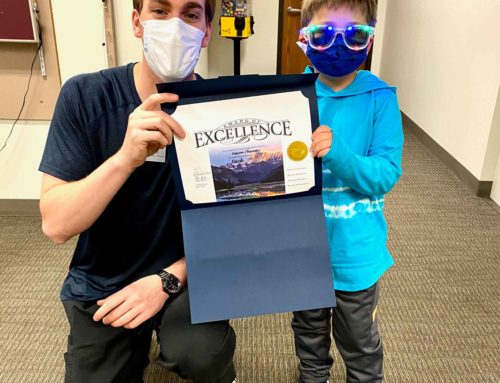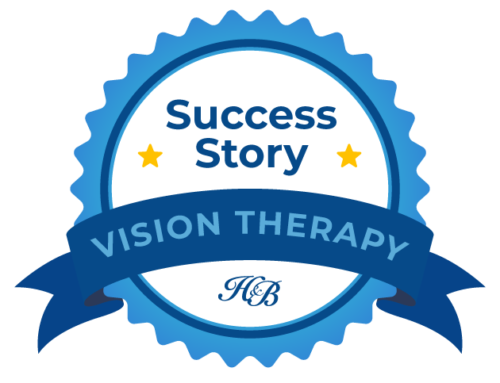Just to warn you right from the beginning: This is not a happy, smiley article about how great vision therapy was for me. The end result was great, but therapy was tough, frustrating, and exhausting. And some days, it felt pointless.
I was in tears after every appointment the first couple months. I didn’t want to go, especially since I had to take Lyft or ask a friend to drive me. (I couldn’t drive, because a bad concussion had left me with double and blurry vision. More on that later.)
Therapy was awful some days, but giving up was never an option. I needed to see again! So I kept going back. And over time, it got much better. But in the beginning, it was brutal.
Learning to See Again
Vision therapy had a profound effect on me. I started weekly therapy in January 2018, about four months after my concussion when the severe migraines ended. In June, about five months later, I was done. My vision was almost back to normal, and life felt promising again.
During those five months, my therapist taught my eyes how to see correctly again, but he also taught me much more. Here are some life lessons I learned:
1. Walking isn’t easy. And neither is seeing!
Walking and seeing are things I’ve taken for granted all my life. Want coffee? Just walk to the kitchen, grab a mug, and fill it! No big deal, right?It turns out, fainting – and hitting your head really hard when you fall – can mess up your vestibular system, which controls balance. And, in my case, hitting my head also hurt my vision.
My eyes wouldn’t work together, so I saw double. And what wasn’t double was fuzzy and blurry. For someone who had never needed glasses, it was a huge shock that my world could be upended so easily. I was terrified it would stay that way forever.
How was I supposed to function if I couldn’t see straight without a pirate patch covering one eye? How was I supposed to pour hot coffee into a mug when I had to close one eye to get rid of the double vision?
Simple things, like walking or getting coffee, weren’t simple anymore. But slowly, the therapy started working, my vision got better, and I could walk with both eyes open. No more eye patch. And no more closing one eye, which looked like I was winking at people all the time!
2. Falling down hurts.
It’s really embarrassing, but I still stumble or fall. Sometimes I miss a stair or step wrong on an uneven patch in the sidewalk. Or I misjudge the height difference between two surfaces, like stepping from the sidewalk down to the street.Usually I catch myself if I start to tip a little, or my boyfriend grabs my arm. But sometimes, I fall. Flat on my face! It’s embarrassing, and it really hurts. But giving up wasn’t an option during therapy, and it still isn’t now. I’ve got too much life to live!
3. I have to listen to my body. And trust it.
This has been a huge lesson, and I still haven’t mastered it. My therapist mentioned it at my very first appointment, but it didn’t even start to sink in until much later. He reminded me every week that I need to listen to my body and do what it says. After giving years of time and attention to my kids’ needs, I had to learn how to take care of myself.I walked heel-to-toe with special glasses that visually tilted the floor. I tried to stay balanced in front of a huge monitor while standing on a balance board that tipped side to side — all while touching random lights when they flashed across the screen. I walked up and down stairs too many times to count. I even walked toward a small ball swinging from the ceiling while turning my head side to side.
Sounds easy, but it wasn’t. And it wasn’t fun. I constantly asked in frustration, “Can a normal person do this???” But it taught me to be aware of where my body was and to trust myself.
4. I can now look through TV screens.
Well, not actually, but kind of. One of many exercises my therapist designed for me was especially frustrating. I looked at a TV screen with a big image that looked like a QR code. Inside one quadrant of the large image was a smaller, slightly different image that also looked like a QR code. The only way to see the smaller image was to focus my eyes as if I was looking through the TV to the wall behind. Then the smaller image would come into view.It was maddening! And I was horrible at it. Truly awful! Tears came regularly. But my therapist kept reminding me why I was doing this. And later, I got better at it — and actually looked forward to seeing how well I could do. It became an addictive game.
5. I can drive again!!!
This was HUGE! Seeing better and feeling more confident, I started driving after just a couple months of therapy. It was a tremendous boost!I still cried almost every week after my appointments, but now I was sitting in my own car crying. At first, I only drove on roads with slow speeds, but I was driving myself, not relying on my kids or Lyft. I was thrilled!
My eyes and my brain don’t always connect instantaneously like they did before the concussion, though. It’s not a big deal in regular life, but it makes me a little nervous when driving. So I don’t zip in and out of traffic anymore. I’m much more mellow now. I drive the speed limit (not 5-10mph over, like I used to), and I’m usually in the right lane.
6. I need to be kind to myself.
I still have a long way to go on this. But considering where I started, the progress has been tremendous. My therapist gave me homework every week, and I had to make time to do it. My eyes were my number-one priority, so everyone else’s needs had to come second. It was tough, but I finally learned to be as good to myself as I was to everyone else. And the result was success!
Dreaming Forward
It’s been almost a year since I finished vision therapy. I still see double if I face forward and glance my eyes downward to my feet. It’s a great excuse for ignoring all the crumbs on the kitchen floor! But it’s easy to fix with just a slight downward tip of my head, which puts the crumbs in perfect view.
I now use glasses for driving, so signs are crispy clear more than a block away. And reading glasses with blue-light protection make long workdays on my laptop easier. My 50th birthday is only a few months away, so reading glasses were in my future anyway, even without the concussion.
I still have a circle of Post-It Notes on the wall by my front door, and there’s a small blue ball hanging in my office doorway. They’re reminders to practice what I learned in therapy and to remember how far I’ve come. I never want to lose the gains I made.
I know official tests prove my vision today is worse than before my concussion, but I respectfully say they’re wrong. I see life, the world, and myself more clearly and more authentically now.
About the Author
I’m 49 years old and live in Denver, Colorado. I experienced two mild concussions in three years. Both times, I woke during the night, used the bathroom, and then fainted while walking back to bed.
The first time, there was no effect on my vision or balance. Only my teeth and jaw were damaged when I hit the bathroom door face first and then fell to the floor. But two years of braces fixed that!
The second time, though, my eyes and vestibular system were impacted. Double and blurry vision were present from eye level down. No one was awake to see what happened, but there was a new dent in a thin, wooden door between the bathroom and my bed, probably caused by my head when I fainted. Despite several months of migraines, I returned to my part-time job in medical marketing communications, which I still do today.
Vision therapy and ongoing evaluations were provided at Hellerstein & Brenner Vision Center in Denver, Colorado. Dr. Amy Elsila, O.D., conducted initial evaluations. Dr. Lynn Hellerstein, O.D., FCOVD, FAAO, oversaw therapy and conducted ongoing evaluations. I’m very grateful to them.
But the hero of my story is Taylor Benton, COVT. He provided weekly vision therapy and taught me how to see again. I will be forever grateful for his expertise, inspiration, and endless patience. This story would not have the same happy ending without him.


